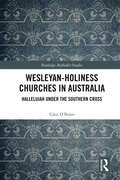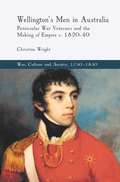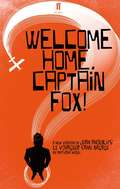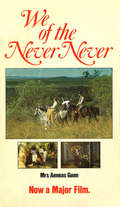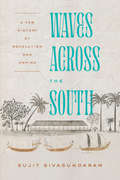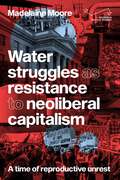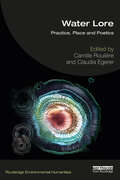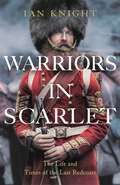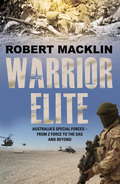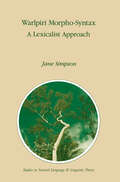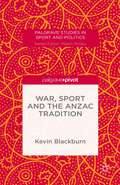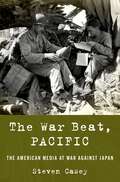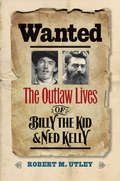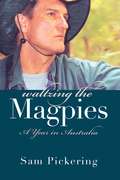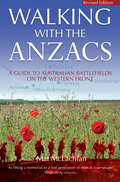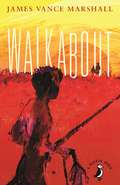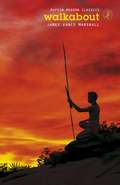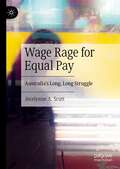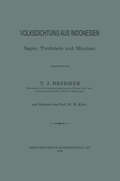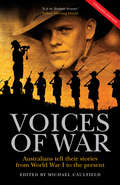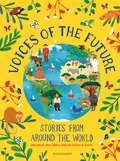- Table View
- List View
Wesleyan-Holiness Churches in Australia: Hallelujah under the Southern Cross (Routledge Methodist Studies Series)
by Glen O'BrienMost Wesleyan-Holiness churches started in the US, developing out of the Methodist roots of the nineteenth-century Holiness Movement. The American origins of the Holiness movement have been charted in some depth, but there is currently little detail on how it developed outside of the US. This book seeks to redress this imbalance by giving a history of North American Wesleyan-Holiness churches in Australia, from their establishment in the years following the Second World War, as well as of The Salvation Army, which has nineteenth-century British origins. It traces the way some of these churches moved from marginalised sects to established denominations, while others remained small and isolated. Looking at The Church of God (Anderson), The Church of God (Cleveland), The Church of the Nazarene, The Salvation Army, and The Wesleyan Methodist Church in Australia, the book argues two main points. Firstly, it shows that rather than being American imperialism at work, these religious expressions were a creative partnership between like-minded evangelical Christians from two modern nations sharing a general cultural similarity and set of religious convictions. Secondly, it demonstrates that it was those churches that showed the most willingness to be theologically flexible, even dialling down some of their Wesleyan distinctiveness, that had the most success. This is the first book to chart the fascinating development of Holiness churches in Australia. As such, it will be of keen interest to scholars of Wesleyans and Methodists, as well as religious history and the sociology of religion more generally.
Wellington's Men in Australia: Peninsular War Veterans and the Making of Empire c.1820-40 (War, Culture and Society, 1750 –1850)
by C. WrightAn exploration of the little-known yet historically important emigration of British army officers to the Australian colonies in the aftermath of the Napoleonic Wars. The book looks at the significant impact they made at a time of great colonial expansion, particularly in new south Wales with its transition from a convict colony to a free society.
Welcome Home, Captain Fox! (Faber Drama Ser.)
by Anthony WeighIt's the legendary hot summer of 1959 and while the Cold War rages and America tunes into I Love Lucy, Captain Jack Fox - believed missing in action in the fields of France fifteen years before - is about to be reunited with his family in the Hamptons.But is this really Jack Fox? And if it isn't, who is this man? And why are there twenty-two other families so intent on claiming him as their own?A sparkling comedy of identity, lost and found, based on Jean Anouilh's hit 1937 play, Le Voyageur sans bagage, Anthony Weigh's Welcome Home, Captain Fox! premiered at the Donmar Warehouse, London, in February 2016.
We Of The Never Never (Classic Ser.)
by Aeneas GunnNewly married, Jeannie Gunn accompanies her husband to 'The Elsey', the huge cattle station in the Northern Territory, several hundred miles from the nearest town. She is one of the few white women in the area and her presence is at first resented by the stockmen until her warmth and spirit win their affection and respect. This is one of the few autobiographies written by a woman to chronicle the life of the pioneers of the outback. In the style of the bush storyteller, Mrs Gunn conveys with moving simplicity the beauty and cruelty of the land, and the isolation and loneliness, comradeship and kindness of the early settlers.
Waves Across the South: A New History of Revolution and Empire
by Sujit SivasundaramThis is a story of tides and coastlines, winds and waves, islands and beaches. It is also a retelling of indigenous creativity, agency, and resistance in the face of unprecedented globalization and violence. Waves Across the South shifts the narrative of the Age of Revolutions and the origins of the British Empire; it foregrounds a vast southern zone that ranges from the Arabian Sea and southwest Indian Ocean across to the Bay of Bengal, and onward to the South Pacific and the Tasman Sea. As the empires of the Dutch, French, and especially the British reached across these regions, they faced a surge of revolutionary sentiment. Long-standing venerable Eurasian empires, established patterns of trade and commerce, and indigenous practice also served as a context for this transformative era. In addition to bringing long-ignored people and events to the fore, Sujit Sivasundaram opens the door to new and necessary conversations about environmental history, the consequences of historical violence, the legacies of empire, the extraction of resources, and the indigenous futures that Western imperialism cut short. The result is nothing less than a bold new way of understanding our global past, one that also helps us think afresh about our shared future.
Waves Across the South: A New History of Revolution and Empire
by Sujit SivasundaramThis is a story of tides and coastlines, winds and waves, islands and beaches. It is also a retelling of indigenous creativity, agency, and resistance in the face of unprecedented globalization and violence. Waves Across the South shifts the narrative of the Age of Revolutions and the origins of the British Empire; it foregrounds a vast southern zone that ranges from the Arabian Sea and southwest Indian Ocean across to the Bay of Bengal, and onward to the South Pacific and the Tasman Sea. As the empires of the Dutch, French, and especially the British reached across these regions, they faced a surge of revolutionary sentiment. Long-standing venerable Eurasian empires, established patterns of trade and commerce, and indigenous practice also served as a context for this transformative era. In addition to bringing long-ignored people and events to the fore, Sujit Sivasundaram opens the door to new and necessary conversations about environmental history, the consequences of historical violence, the legacies of empire, the extraction of resources, and the indigenous futures that Western imperialism cut short. The result is nothing less than a bold new way of understanding our global past, one that also helps us think afresh about our shared future.
Water struggles as resistance to neoliberal capitalism: A time of reproductive unrest (Progress in Political Economy)
by Madelaine MooreThis book provides an important intervention into social reproduction theory and the politics of water. Presenting an incorporated comparison, it analyses the conjuncture following the 2007 financial crisis through the lens of water expropriation and resistance. This brings into view the way that transnational capital has made use of and been facilitated by the strategic selectivities of both the Irish and the Australian state, as well as the particular class formations that emerged in resistance to such water grabs. What is revealed is a crisis-ridden system that is marked by increasing reproductive unrest – class understood through the lens of social reproduction theory. As an important analysis of two significant water struggles, the book makes a compelling argument for integrating the study of social movements within critical political economy.
Water struggles as resistance to neoliberal capitalism: A time of reproductive unrest (Progress in Political Economy)
by Madelaine MooreThis book provides an important intervention into social reproduction theory and the politics of water. Presenting an incorporated comparison, it analyses the conjuncture following the 2007 financial crisis through the lens of water expropriation and resistance. This brings into view the way that transnational capital has made use of and been facilitated by the strategic selectivities of both the Irish and the Australian state, as well as the particular class formations that emerged in resistance to such water grabs. What is revealed is a crisis-ridden system that is marked by increasing reproductive unrest – class understood through the lens of social reproduction theory. As an important analysis of two significant water struggles, the book makes a compelling argument for integrating the study of social movements within critical political economy.
Water Lore: Practice, Place and Poetics (Routledge Environmental Humanities)
by Camille Roulière Claudia EgererLocated within the field of environmental humanities, this volume engages with one of the most pressing contemporary environmental challenges of our time: how can we shift our understanding and realign what water means to us? Water is increasingly at the centre of scientific and public debates about climate change. In these debates, rising sea levels compete against desertification; hurricanes and floods follow periods of prolonged drought. As we continue to pollute, canalise and desalinate waters, the ambiguous nature of our relationship with these entities becomes visible. From the paradisiac and pristine scenery of holiday postcards through to the devastated landscapes of post-tsunami news reports, images of waters surround us. And while we continue to damage what most sustains us, collective precarity grows. Breaking down disciplinary boundaries, with contributions from scholars in the visual arts, history, earth systems, anthropology, architecture, literature and creative writing, archaeology and music, this edited collection creates space for less-prominent perspectives, with many authors coming from female, Indigenous and LGBTQIA+ contexts. Combining established and emerging voices, and practice-led research and critical scholarship, the book explores water across its scientific, symbolic, material, imaginary, practical and aesthetic dimensions. It examines and interrogates our cultural construction and representation of water and, through original research and theory, suggests ways in which we can reframe the dialogue to create a better relationship with water sources in diverse contexts and geographies. This expansive book brings together key emerging scholarship on water persona and agency and would be an ideal supplementary text for discussions on the blue humanities, climate change, environmental anthropology and environmental history.
Water Lore: Practice, Place and Poetics (Routledge Environmental Humanities)
by Camille Roulière Claudia EgererLocated within the field of environmental humanities, this volume engages with one of the most pressing contemporary environmental challenges of our time: how can we shift our understanding and realign what water means to us? Water is increasingly at the centre of scientific and public debates about climate change. In these debates, rising sea levels compete against desertification; hurricanes and floods follow periods of prolonged drought. As we continue to pollute, canalise and desalinate waters, the ambiguous nature of our relationship with these entities becomes visible. From the paradisiac and pristine scenery of holiday postcards through to the devastated landscapes of post-tsunami news reports, images of waters surround us. And while we continue to damage what most sustains us, collective precarity grows. Breaking down disciplinary boundaries, with contributions from scholars in the visual arts, history, earth systems, anthropology, architecture, literature and creative writing, archaeology and music, this edited collection creates space for less-prominent perspectives, with many authors coming from female, Indigenous and LGBTQIA+ contexts. Combining established and emerging voices, and practice-led research and critical scholarship, the book explores water across its scientific, symbolic, material, imaginary, practical and aesthetic dimensions. It examines and interrogates our cultural construction and representation of water and, through original research and theory, suggests ways in which we can reframe the dialogue to create a better relationship with water sources in diverse contexts and geographies. This expansive book brings together key emerging scholarship on water persona and agency and would be an ideal supplementary text for discussions on the blue humanities, climate change, environmental anthropology and environmental history.
Warriors in Scarlet: The Life and Times of the Last Redcoats
by Ian KnightIan Knight's Warriors in Scarlet is a comprehensive and stirring history of the Victorian army between 1837 to 1860, from the Battle of Bossendon Wood to the Crimean War, a period of seismic change.An acclaimed military historian, Knight draws on first-hand accounts to show us the reality of life for the British soldier in this era – the drudgery of peace-time service, the excitement and privations of posting overseas, the floggings and desertions, the regimental pride and comradeship. The rapid expansion of the empire saw the army fighting in small wars across the world and Knight reveals the brutal reality of this colonial conflict from both sides. British soldiers trained in tactics that had beaten Napoleon were forced to adapt when faced with warriors with very different skills fighting on their home ground. Knight vividly recreates the action, from bloody skirmishes in Southern Africa and siege warfare in New Zealand to disasters like the 1842 retreat from Kabul and Chillianwalla in the Punjab – but shows that in reality the army won more than four-fifths of the battles they fought in this era. He describes how, by 1860 with their redcoats increasingly replaced by khaki, the British army was a more professional, efficient and increasingly ruthless fighting force.
Warrior Elite: Australia’s special forces Z Force to the SAS intelligence operations to cyber warfare
by Robert MacklinA compelling account of Australia's intelligence organisations and special forces - from the early days of the commandos during World War II through to the SAS of today and the cyber wars of the future. From the co-author of SAS Sniper.Warrior Elite is a unique and compelling account of Australia's special forces and intelligence operations - ranging from the early special forces of World War II to the establishment and development of the SAS and Commando Regiments as the elite fighters of today, and from the Australian Security Intelligence Service to the Australian Signals Directorate and ASIO. It is an authoritative, gripping and thoroughly up-to-date account of both the history and current state of our special forces and intelligence bodies - and gives a unique glimpse into the warfare of the future. Our future.Robert Macklin has conducted dozens of exclusive interviews and uncovered incredible, daring and sometimes heartbreaking stories of the elite troops that guard our nation and engage in secret operations around the world. He has had significant cooperation from numerous sources within the special forces and the various intelligence agencies.Both thoroughly researched and colourfully written, Warrior Elite will attract the reader of action memoirs as well as those interested in broader military history and espionage.
Warlpiri Morpho-Syntax: A Lexicalist Approach (Studies in Natural Language and Linguistic Theory #23)
by J. SimpsonWar, Sport and the Anzac Tradition (Palgrave Studies in Sport and Politics)
by Kevin BlackburnCommemoration of war is done through sport on Anzac Day to remember Australia's war dead. War, Sport and the Anzac Tradition traces the creation of this sporting tradition at Gallipoli in 1915, and how it has evolved from late Victorian and Edwardian ideas of masculinity extolling prowess on the sports field as fostering prowess on the battlefield.
The War Beat, Pacific: The American Media at War Against Japan
by Steven CaseyThe definitive history of American war reporting in the Pacific theater of World War II, from the attack on Pearl Harbor to the atomic bombings of Hiroshima and Nagasaki. After almost two years slogging with infantrymen through North Africa, Italy, and France, Ernie Pyle immediately realized he was ill-prepared for covering the Pacific War. As Pyle and other war correspondents discovered, the climate, the logistics, and the sheer scope of the Pacific theater had no parallel in the war America was fighting in Europe. From Pearl Harbor to Hiroshima and Nagasaki, The War Beat, Pacific provides the first comprehensive account of how a group of highly courageous correspondents covered America's war against Japan, what they witnessed, what they were allowed to publish, and how their reports shaped the home front's perception of some of the most pivotal battles in American military history. In a dramatic and fast-paced narrative based on a wealth of previously untapped primary sources, Casey takes us from MacArthur's doomed defense on the Philippines and the navy's overly strict censorship policy at the time of Midway, through the bloody battles on Guadalcanal, New Guinea, Tarawa, Saipan, Leyte and Luzon, Iwo Jima and Okinawa, detailing the cooperation, as well as conflict, between the media and the military, as they grappled with the enduring problem of limiting a free press during a period of extreme crisis. The War Beat, Pacific shows how foreign correspondents ran up against practical challenges and risked their lives to get stories in a theater that was far more challenging than the war against Nazi Germany, while the US government blocked news of the war against Japan and tried to focus the home front on Hitler and his atrocities.
The War Beat, Pacific: The American Media at War Against Japan
by Steven CaseyThe definitive history of American war reporting in the Pacific theater of World War II, from the attack on Pearl Harbor to the atomic bombings of Hiroshima and Nagasaki. After almost two years slogging with infantrymen through North Africa, Italy, and France, Ernie Pyle immediately realized he was ill-prepared for covering the Pacific War. As Pyle and other war correspondents discovered, the climate, the logistics, and the sheer scope of the Pacific theater had no parallel in the war America was fighting in Europe. From Pearl Harbor to Hiroshima and Nagasaki, The War Beat, Pacific provides the first comprehensive account of how a group of highly courageous correspondents covered America's war against Japan, what they witnessed, what they were allowed to publish, and how their reports shaped the home front's perception of some of the most pivotal battles in American military history. In a dramatic and fast-paced narrative based on a wealth of previously untapped primary sources, Casey takes us from MacArthur's doomed defense on the Philippines and the navy's overly strict censorship policy at the time of Midway, through the bloody battles on Guadalcanal, New Guinea, Tarawa, Saipan, Leyte and Luzon, Iwo Jima and Okinawa, detailing the cooperation, as well as conflict, between the media and the military, as they grappled with the enduring problem of limiting a free press during a period of extreme crisis. The War Beat, Pacific shows how foreign correspondents ran up against practical challenges and risked their lives to get stories in a theater that was far more challenging than the war against Nazi Germany, while the US government blocked news of the war against Japan and tried to focus the home front on Hitler and his atrocities.
Wanted: The Outlaw Lives of Billy the Kid and Ned Kelly (The Lamar Series in Western History)
by Robert M. UtleyThe oft-told exploits of Billy the Kid and Ned Kelly survive vividly in the public imaginations of their respective countries, the United States and Australia. But the outlaws’ reputations are so weighted with legend and myth, the truth of their lives has become obscure. In this adventure-filled double biography, Robert M. Utley reveals the true stories and parallel courses of the two notorious contemporaries who lived by the gun, were executed while still in their twenties, and remain compelling figures in the folklore of their homelands. Robert M. Utley draws sharp, insightful portraits of first Billy, then Ned, and compares their lives and legacies. He recounts the adventurous exploits of Billy, a fun-loving, expert sharpshooter who excelled at escape and lived on the run after indictment for his role in the Lincoln Country War. Bush-raised Ned, the son of an Irish convict father and Irish mother, was a man whose outrage against British colonial authority inspired him to steal cattle and sheep, kill three policemen, and rob banks for the benefit of impoverished Irish sympathizers. Utley recounts the exploits of the notorious young men with accuracy and appeal. He discovers their profound differences, despite their shared fates, and illuminates the worlds in which they lived on opposite sides of the globe.
Waltzing the Magpies: A Year in Australia
by Sam PickeringPraise for Sam Pickering: "The art of the essay as delivered by Mr. Pickering is the art of the front porch ramble." ---The New York Times Book Review "Reading Pickering . . . is like taking a walk with your oldest, wittiest friend." ---Smithsonian "What a joy it is to 'mess around' with Professor Sam Pickering!" ---The Chattanooga Times "Pickering is a barefoot observer of the quotidian who revels in the spectacle and its gift for surprise, prefers the rumpled to the starched, has raised puttering and messing about to an art form, and wrings from it more than a pennyworth of happiness and a life well lived." ---Kirkus Reviews The movie Dead Poets Society is where most Americans first met Sam Pickering, the University of Connecticut English professor. Robin Williams plays the lead character (loosely based on Pickering), an idiosyncratic instructor who employs some over-the-top teaching methods to keep his subjects fresh and his students learning. Fewer know that Pickering is the author of more than 16 books and nearly 200 articles, or that he's inspired thousands of university students to think in new ways. And, while Williams may have captured Pickering's madcap classroom antics, he didn't uncover the other side of the author-Sam Pickering as one of our great American men of letters. Like the music of Mozart, the painting of Picasso, or the poetry of Emily Dickinson, you can spot Pickering's writing a mile away; there's no mistaking the Pickering pen. As an ample demonstration of the author's literary gifts, Waltzing the Magpies is his unabashedly lush and Technicolor travelogue from Down Under. On the face of it, Waltzing is the chronicle of a sabbatical year spent with family in Australia. Yet beneath the surface Pickering's big themes-family, nature, seizing the moment-move in a powerful current that frequently bursts out in moments of ecstatic revelation and intense sensual flourish. Through it all Pickering weaves stories from his fictional Southern town of Carthage, Tennessee, especially when the goings of the outside world get rough. Waltzing the Magpies is classic Pickering at the height of his literary powers, and places him in the company of such great American essayists as E. B. White and James Thurber, but with an irony and observational prowess that is pure Pickering.
Walking with the ANZACS: The authoritative guide to the Australian battlefields of the Western Front
by Mat McLachlan'[Mat McLachlan's] knowledge of the front is comprehensive' - Sydney Morning HeraldA complete guide to the Australian battlefields of the Western Front 1916-18.Walking with the ANZACs aims to become the new essential companion for Australians visiting the Western Front. Each of the 14 most important Australian battlefields is covered with descriptions of the battles and Australia’s involvement in it.The book presents a well-illustrated walking tour across the old battlefields. The tours are designed along easily accessible walking routes and show readers battlefield landmarks that still exist, memorials to the men who fought there and the cemeteries where many of them still lie. In this way the visitor will see the battlefield in much the same way as the original ANZACs did, and gain a greater appreciation of the site’s significance. Importantly, the tours are not written for military experts, but for ordinary visitors whose military knowledge may be limited.More than just a handy travel guide, Walking with the ANZACs is an absorbing read for armchair travellers and students of the First World War who may not have had the opportunity to visit the battle fields and walk in the footsteps of the first ANZACs.
Walkabout (Penguin Joint Venture Readers Ser.)
by James Vance MarshallMary and her young brother Peter are the only survivors of an aircrash in the middle of the Australian outback. Facing death from exhaustion and starvation, they meet an aboriginal boy who helps them to survive, and guides them along their long journey. But a terrible misunderstanding results in a tragedy that neither Mary nor Peter will ever forget . . .
Walkabout (Penguin Joint Venture Readers Ser.)
by James Vance MarshallMary and her young brother Peter are the only survivors of an aircrash in the middle of the Australian desert. Facing death from exhaustion and starvation, they meet an aboriginal boy who helps them to survive, and guides them along their long journey. But a terrible misunderstanding results in a tragedy that neither Mary nor Peter will ever forget...
Wage Rage for Equal Pay: Australia’s Long, Long Struggle
by Jocelynne A. ScuttThis book makes a major contribution to the continuing legal and historical struggle for equal pay in Australia, with international references, including Canada, the UK and US. It takes law, history and women’s and gender studies to analyse and recount campaigns, cases and debates. Industrial bodies federally and around Australia have grappled with this issue from the early-twentieth century onwards. This book traces the struggle through the decades, looking at women's organisations activism and demands, union ‘pro’ and ‘against’ activity, and the 'official' approach in tribunals, boards and courts.
The Voices of War: Australians tell their stories from World War I to the present
by Michael CaulfieldDrawn from engagements ranging from World War I through to operations in East Timor and Iraq, these stories are taken from the Australians at War Film Archive, a collection of the memories of more than 2000 Australians who have served, both on the front line and at home.Some are unbelievably, unbearably tragic, even after sixty or seventy years; others are the golden memories of happy, albeit unusual, times. And, more often than not, they are stories that have never been shared with others, even family members. There are stories from winners of the Victoria Cross; from the POW camps of Asia and Europe; from the patrols of Vietnam, through to those who served as peacekeepers in Rwanda and Somalia.There are stories from nurses, from those who have volunteered to serve with aid agencies and stories of ordinary Australians caught up by circumstances and by duty, in wartime. These are their words.
Voices of the Future: Stories from Around the World
by Irina BokovaA wonderful anthology of eight stories addressing children's rights and sustainable development, written by child authors from all around the world and produced in conjunction with UNESCO's Voices of Future Generations initiative.UNESCO's Voices of Future Generations initiative works to empower children all around the world. The stories in this book are written by children aged between 8 and 12 from every corner of the globe: Canada, Mexico, Papua New Guinea, Samoa, South Africa, Taiwan, Uruguay and United Arab Emirates. With beautiful, full colour illustrations throughout by four talented illustrators, Jhonny Nunez, Giovana Medeiros, Marco Guadalupi and Mona Meslier Menaua, this book is the perfect way to engage children with the issues facing the planet and the lives of children in other countries.The children's stories are imaginative, empowering and inspiring. They focus on the UN Convention on the Rights of the Child and the Sustainable Development Goals and present likeable characters who go on problem-solving adventures to fix the problems faced in each region. The book features a foreword by Irina Bokova, Director General of UNESCO.'... and together, the children could build a better future.'Book band: Dark Blue
